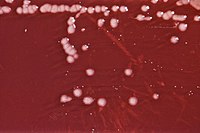
Photo from wikipedia
Pseudomonas aeruginosa produce pyocyanin, which is an extracellular secondary metabolite and multifunctional pigment. In this study, the effects of several surfactants (Tween 20, Tween 80 and Triton X-100) and organic… Click to show full abstract
Pseudomonas aeruginosa produce pyocyanin, which is an extracellular secondary metabolite and multifunctional pigment. In this study, the effects of several surfactants (Tween 20, Tween 80 and Triton X-100) and organic solvents (toluene and chloroform) on pyocyanin production and cell growth were investigated in submerged culture of P. aeruginosa OG1. Organic solvents were found to be more effective in the production of pyocyanin. The maximum production of pyocyanin (33 mg/L) was achieved when 0.2% toluene was added at the stationary growth phase (30 h), corresponding to significant increase of 312% compared with the control (8 mg/L). With the addition of toluene, pyocyanin production was significantly increased, but bacterial biomass reduced. Production of alkaline protease was also affected by toluene addition. It was found that the ratio of saturated/unsaturated fatty acids in the bacterial biomass significantly increased when toluene addition to the medium. This study revealed that with a novel strategy, the addition of toluene to the fermentation medium significantly increased pyocyanin production. These findings suggest that solvent-assisted fermentation strategy can be used in microbial fermentations to increase the production of biotechnological products such as industrially important pigment and enzyme. This study is a first investigation on the stimulation of pyocyanin release in the medium of P. aeruginosa cultures by the addition of toluene.
Journal Title: 3 Biotech
Year Published: 2019
Link to full text (if available)
Share on Social Media: Sign Up to like & get
recommendations!